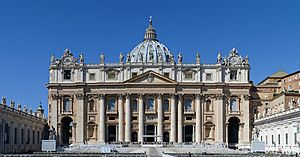Carlo Maderno facts for kids
Quick facts for kids
Carlo Maderno
|
|
|---|---|

Carlo Maderno in a portrait by an unknown author
|
|
| Born | 1556 Capolago, Swiss Confederacy
|
| Died | January 30, 1629 |
| Nationality | Italian |
| Known for | Architecture |
| Movement | Baroque |
Carlo Maderno (born 1556, died 1629) was a famous Italian architect. He was born in a region of Switzerland called Ticino. Maderno is known as one of the first and most important architects of the Baroque style.
His designs for the front parts (called façades) of churches like Santa Susanna, St. Peter's Basilica, and Sant'Andrea della Valle were very important. They helped shape the look of Italian Baroque buildings. Some people believe he was the brother of the sculptor Stefano Maderno, but this is not certain.
Contents
Carlo Maderno's Early Life and Career
Maderno was born in Capolago, which is now part of Switzerland. He started his career working with marble. In 1588, he moved to Rome with his four brothers. There, he worked with his uncle, Domenico Fontana, who was also an architect. Maderno's experience with sculpting marble helped him a lot in his architecture work.
Designing the Santa Susanna Façade
Maderno's first big project on his own was the façade of the Santa Susanna church. He designed it between 1597 and 1603. This design was very new and exciting for its time. It moved away from the older, more formal style called Mannerism.
The Santa Susanna façade uses columns and pilasters (flat columns attached to a wall) in a lively way. The middle part sticks out, making the building look more dynamic. This design showed a playful approach to classic building rules, while still keeping things organized.
Working on St. Peter's Basilica
Maderno's work on Santa Susanna caught the attention of Pope Paul V. The Pope then made him the main architect for St. Peter's Basilica in Rome. This was a huge and very important job.
Changing Michelangelo's Plans
Maderno had to change the original plans for St. Peter's Basilica. The famous artist Michelangelo had designed the church to be shaped like a Greek cross. Maderno was asked to make the church longer, changing it to a Latin cross shape. He also had to design a grand façade for the front.
The façade was finished in 1612. It has a special balcony above the main door. From this balcony, the Pope could give blessings to the crowds below. Some people have criticized this longer design. They say it makes it harder to see the church's famous dome from St. Peter's Square.
Other Important Buildings
Most of Maderno's work involved changing or adding to buildings that already existed. He didn't often design completely new buildings from scratch.
Santa Maria della Vittoria
One of the few churches Maderno designed (besides its façade) was Santa Maria della Vittoria. He worked on it from 1608 to 1620. This church is also famous for the beautiful "Ecstasy of St Theresa" sculpture by Bernini.
Sant'Andrea della Valle
Maderno's most famous work is often considered to be the church of Sant'Andrea della Valle. However, he didn't design the whole church. He created the façade and the large dome. This dome is the third largest in Rome, after St. Peter's and the Pantheon.
The church itself was started by other architects. Maderno's dome was built between 1621 and 1625. The façade was not fully finished when Maderno died. Another architect, Carlo Fontana, completed it later, following Maderno's original ideas. Maderno's design for this façade added more movement and depth compared to older styles.
Palaces and Chapels
Maderno also worked on several important palaces. These include the Quirinal Palace, which was a Papal palace. He also worked on the Papal palace in Castel Gandolfo. Another major project was the Palazzo Barberini for Pope Urban VIII. In this palace, Maderno's work is sometimes overshadowed by details added by famous artists like Bernini and Borromini. His design for the Palazzo Mattei (1598–1618) is a great example of his palace designs.
He also designed special chapels inside existing churches. These include the Chapel of St Lawrence in San Paolo fuori le Mura and the Cappella Caetani in Santa Pudenziana. Maderno also designed the base for the Marian column in front of Basilica di Santa Maria Maggiore. This column later became a model for many similar columns.
Carlo Maderno passed away in Rome on January 31, 1629, when he was 73 years old. He was buried in the church of San Giovanni dei Fiorentini.
Images for kids
See also
 In Spanish: Carlo Maderno para niños
In Spanish: Carlo Maderno para niños



